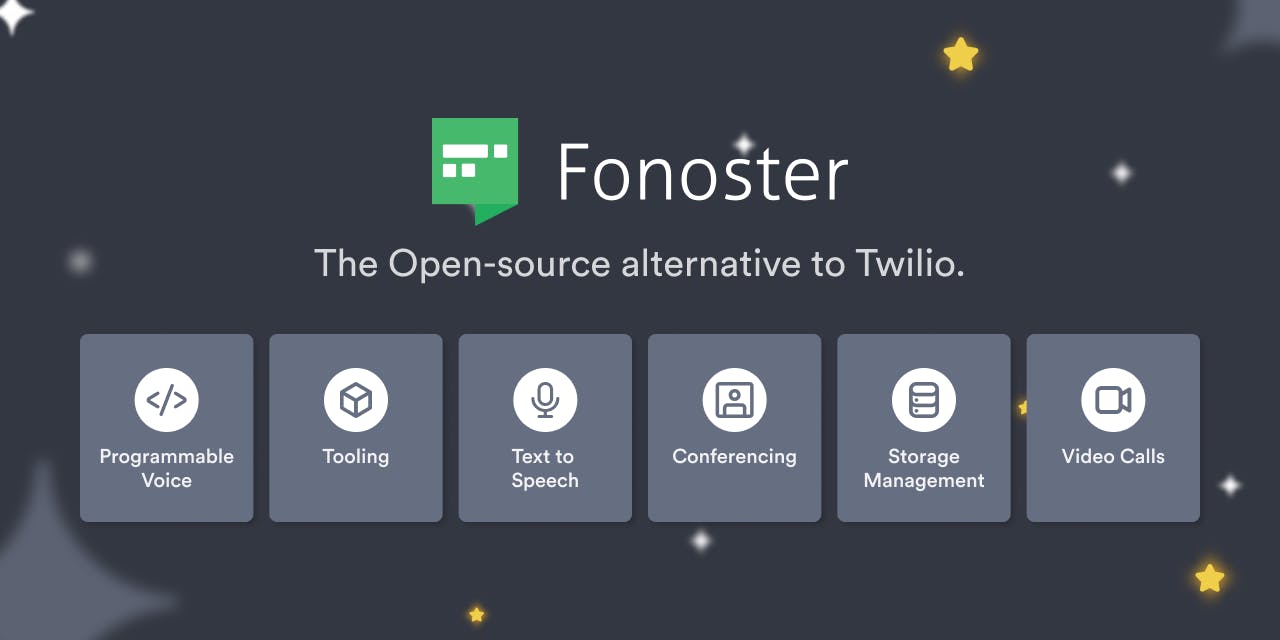Introducing Fonoster: An Open source alternative to Twilio
Let's learn about the open-source tool, Fonoster which will enable you to host a stack application on a server that includes VOIP, SMS, and mail.
The link to the original post is here
Introduction
Fonoster Inc is developing Project Fonos, a simple Programmable Telecommunications Stack that allows enterprises to connect telephone services through the Internet using a fully cloud-based utility.
Let’s learn more about this open-source alternative to Twilio, which enables you to host a stack application on your own server that includes VOIP, SMS, mail, chat, and video. Also for individuals who want complete control over their platform and data, this is an excellent option.
What is Fonoster?
 Fonoster say goes, 'Engage with your customers via phone or text on a single, easy-to-use platform.
Fonoster say goes, 'Engage with your customers via phone or text on a single, easy-to-use platform.
Fonoster allows its customers to create their website with a smart voice application that matches their company’s needs without the clutter of unnecessary features or historically onerous adjustments.
Why Fonoster?
Businesses could use Fonoster to create, test, and deploy voice services. Users can easily add automated calls into their apps for telemarketing, shipment notifications, reminders, emergency calls, games, surveys, and other purposes. RESTfulAPI-based tools are available.
- Telecommunications that may be programmed without being locked in
- Use Javascript or Typescript to create your application.
- One-click installation and a powerful CLI
- An active developer community
Features
Fonoster is an open-source Twilio alternative. With a single easy-to-use platform, you can communicate with your customers via phone or messaging.
Among its features are:
- Initialization of the cloud with Cloud-Init
- Initialization of the cloud with Cloud-Init
- Easy implementation of PBX features
- Voice Applications with Programmability
- Support for Amazon Simple Storage Service in the NodeJS SDK Web SDK (S3)
- Let's Encrypt protects API endpoints.
- Role-Based Access Control Authentication with OAuth2 Authentication using JWT (RBAC)
- Command-line Tool with Plugins
- Google Speech API support
- Experimental support for Cloud Functions
- Experimental support for Secret management
Code Examples
A Voice Application is a server that manages the flow of a call. Any combination of the following verbs can be used in a Voice Application:
- Answer: Accepts an incoming call as an answer.
- Hangup: Terminates the call.
- Play: Returns the sound from a URL or file to the caller party.
- Say: Takes a text, converts it to audio, then broadcasts it back.
- Gather: Gathers DTMF or speech events and returns the outcome.
- SGather: Gets a stream of DTMF and speech outcomes in the future.
- Dial: Forwards the call to an Agent or a PSTN Number.
- Record: It records the calling party's voice and stores it in the storage subsystem.
- Mute: It basically mutes the channel by instructing it to cease delivering media.
- Unmute: This instructs the channel to enable media to flow freely.
How is Fonoster better?
 Project Fonos' main contribution is to explore and create methods for building a highly portable, cloud-based Programmable Telecommunications stack.
Project Fonos' main contribution is to explore and create methods for building a highly portable, cloud-based Programmable Telecommunications stack.
Businesses could use this Programmable Telecommunications stack to dial, answer, set up video sessions, send SMS, and more. There will be no concern about what servers and networks do with such information in the background.
When feasible, Project Fonos employs existing open-source solutions that are best in class, and when required, they create their own. The separate open-source applications are then combined into a unified collection of APIs that resembles a standard CPaaS.
You can find the connectors and VoIP providers that work best for you, then use a single API to integrate them into your Voice Applications in the Fonoster Marketplace.
Closing
Therefore, to conclude, Fonoster helps developers like you to easily create, test and deploy real-time communication. All this while just being open source.
Also, you can find the project roadmap here and join Fonoster’s community by just filling in the form.
So, are you ready to find the right integrations and VoIP providers for your voice apps, then connect them with a single, simple API?
And would you be interested in working with an open-source tool like Fonoster?
Do let me know in the comment section below. I hope you enjoyed reading it!
Feel free to connect with me on LinkedIn | Twitter
If you like my work, you can extend your support by buying me a ☕. Thank you!


